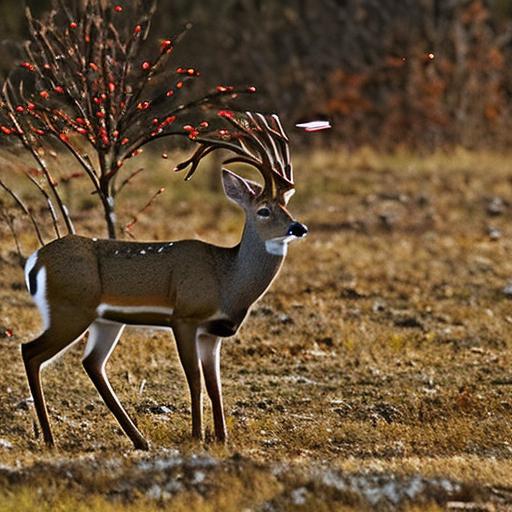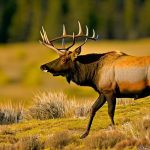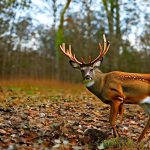Your cart is currently empty!

357 mag deer hunting

357 Mag Deer Hunting is a popular choice among hunters due to its versatility and effectiveness. The .357 Magnum cartridge, originally developed for self-defense purposes, has proven to be a reliable and powerful round for hunting deer. With its high velocity and energy, it is capable of delivering a lethal shot to take down a deer quickly and effectively.
One of the reasons why 357 Mag Deer Hunting is so popular is because it offers hunters the opportunity to use a handgun for hunting. This adds an extra level of challenge and excitement to the hunt, as it requires hunters to get closer to their prey and make accurate shots. Additionally, the compact size and portability of handguns make them easier to carry in the field compared to larger rifles.
Key Takeaways
- 357 Mag cartridges are a popular choice for deer hunting due to their accuracy and power.
- Understanding the ballistics of the cartridge is crucial for selecting the right firearm and ammunition.
- Choosing the right firearm for 357 Mag deer hunting depends on personal preference and hunting conditions.
- Selecting appropriate ammunition involves considering factors such as bullet weight and velocity.
- Preparing for the hunt involves scouting the area, practicing shooting, and packing necessary gear.
Understanding the Ballistics of the 357 Magnum Cartridge
Ballistics refers to the science of how projectiles behave in flight. Understanding the ballistics of a cartridge is crucial for hunters, as it helps them determine the effective range, accuracy, and stopping power of their chosen firearm.
The 357 Magnum Cartridge is known for its impressive ballistics. It typically fires a .357-inch diameter bullet at velocities ranging from 1,200 to 1,600 feet per second (fps), depending on the load. This high velocity, combined with the bullet’s weight and design, results in excellent energy transfer upon impact.
The energy delivered by the 357 Magnum Cartridge is sufficient for taking down deer-sized game at reasonable distances. However, it’s important for hunters to be aware of the limitations of their chosen firearm and ammunition combination. Shot placement is crucial when using a handgun for hunting, as it may not have the same range and accuracy as a rifle.
Choosing the Right Firearm for 357 Mag Deer Hunting
When choosing a firearm for 357 Mag Deer Hunting, there are several factors to consider. First and foremost, hunters should ensure that their chosen firearm is legal for hunting in their area. Some states have specific regulations regarding the use of handguns for hunting, so it’s important to familiarize yourself with the local laws.
Next, hunters should consider the type of firearm that best suits their needs and preferences. There are several options available, including revolvers and semi-automatic pistols. Revolvers are known for their reliability and simplicity, while semi-automatic pistols offer faster follow-up shots.
Popular firearms used for 357 Mag Deer Hunting include the Smith & Wesson Model 686 and the Ruger GP100. These revolvers are known for their durability and accuracy, making them excellent choices for hunting deer.
Selecting Appropriate Ammunition for 357 Mag Deer Hunting
Selecting the right ammunition is crucial for 357 Mag Deer Hunting. The type of ammunition you choose can greatly affect the performance and effectiveness of your shots.
When selecting ammunition, hunters should consider the bullet weight, bullet type, and muzzle velocity. For deer hunting, it is generally recommended to use bullets with a weight between 125 and 180 grains. Heavier bullets tend to offer better penetration, while lighter bullets may offer higher velocities and flatter trajectories.
Bullet type is another important consideration. Hollow point bullets are popular for hunting as they expand upon impact, creating a larger wound channel and increasing the chances of a quick and humane kill. Full metal jacket bullets are not recommended for hunting as they tend to pass through the animal without causing sufficient damage.
Muzzle velocity is also an important factor to consider. Higher muzzle velocities generally result in flatter trajectories and more energy delivered to the target. However, it’s important to find a balance between velocity and bullet weight to ensure proper penetration and expansion.
Preparing for the Hunt: Tips and Strategies for Success
Preparing for a 357 Mag Deer Hunting trip involves several key steps to increase your chances of success. Here are some tips and strategies to consider:
1. Scout the Area: Before heading out on your hunt, take the time to scout the area and familiarize yourself with the terrain. Look for signs of deer activity, such as tracks, rubs, and scrapes. This will help you identify potential hunting spots and increase your chances of encountering deer.
2. Practice Shooting: Shooting accuracy is crucial when using a handgun for hunting. Take the time to practice shooting at various distances and positions to ensure you are comfortable and confident with your firearm. Consider using targets that simulate deer vitals to improve your shot placement.
3. Use Scent Control: Deer have a keen sense of smell, so it’s important to minimize your scent when hunting. Use scent control products, such as scent-free soaps and sprays, and avoid wearing strong-smelling perfumes or colognes. Additionally, hunt with the wind in your favor to prevent deer from detecting your scent.
4. Dress Appropriately: Dressing for the weather and blending in with your surroundings is important for staying comfortable and avoiding detection. Wear camouflage clothing that matches the environment you’ll be hunting in, and consider using scent-blocking clothing to further reduce your scent.
5. Plan Your Shot: When hunting with a handgun, shot placement is crucial. Aim for the vitals, which include the heart and lungs, to ensure a quick and humane kill. Practice shooting from different positions and angles to prepare for various shot opportunities in the field.
Safety Considerations for 357 Mag Deer Hunting
Safety should always be a top priority when hunting, regardless of the firearm or cartridge being used. Here are some safety tips to keep in mind when 357 Mag Deer Hunting:
1. Know Your Target and Beyond: Before taking a shot, always be sure of your target and what lies beyond it. Bullets can travel long distances and pose a risk to others if not properly controlled. Take the time to identify your target and ensure there is a safe backstop.
2. Treat Every Firearm as if it’s Loaded: Always handle firearms with the assumption that they are loaded, even if you believe them to be unloaded. This will help prevent accidents and ensure safe handling practices.
3. Keep Your Finger off the Trigger: Until you are ready to shoot, keep your finger off the trigger and outside the trigger guard. This helps prevent accidental discharges and ensures that you have full control over your firearm.
4. Wear Hunter Orange: In many states, wearing hunter orange is required during firearm deer seasons. This helps increase visibility and reduces the risk of accidental shootings.
5. Communicate with Other Hunters: If hunting in a group, it’s important to communicate with other hunters to ensure everyone is aware of each other’s locations. Use hand signals or radios to maintain contact and avoid any potential accidents.
Tracking and Retrieving Your Deer: Best Practices and Techniques
After making a successful shot, it’s important to track and retrieve your deer properly to ensure a clean and ethical kill. Here are some best practices and techniques for tracking and retrieving your deer:
1. Wait Before Tracking: After making a shot, it’s often best to wait for a period of time before beginning the tracking process. This allows the deer time to expire and reduces the risk of pushing a wounded animal further away.
2. Mark the Spot: Use a GPS device or landmarks to mark the spot where you made the shot. This will help you locate the blood trail and track the deer more effectively.
3. Follow the Blood Trail: Look for signs of blood along the ground, vegetation, or on nearby trees or rocks. Follow the blood trail carefully, paying attention to any changes in direction or intensity.
4. Use Tracking Dogs: If available, consider using a trained tracking dog to help locate your deer. These dogs are trained to follow scent trails and can greatly increase your chances of finding a wounded animal.
5. Be Patient: Tracking a wounded deer can be a time-consuming process. Take your time and be patient, following the blood trail carefully. Avoid rushing or making hasty decisions that could lead to losing the deer.
Field Dressing and Processing Your Deer After the Hunt
Field dressing and processing your deer after the hunt is an important step in preserving the meat and ensuring its quality. Here are the steps to take when field dressing and processing your deer:
1. Field Dressing: Field dressing involves removing the internal organs from the deer to cool down the carcass and prevent spoilage. Start by making a shallow cut from the anus to the base of the ribcage. Then, carefully remove the organs, being cautious not to puncture the intestines or bladder.
2. Skinning: After field dressing, it’s time to skin the deer. Start by making a cut around each leg just above the knee joint. Then, make a cut from the base of the tail to the anus. Use a skinning knife or game shears to carefully remove the hide from the carcass.
3. Quartering: Once the deer is skinned, it can be quartered for easier transportation and processing. Use a bone saw or sharp knife to separate each leg at the joints. Then, remove the backstraps and tenderloins, which are considered some of the most prized cuts of meat.
4. Processing: After quartering, you can further process the meat into various cuts, such as steaks, roasts, or ground meat. Use a sharp knife or meat grinder to cut or grind the meat according to your preferences.
5. Proper Storage: Properly store the processed meat in coolers or refrigerators to prevent spoilage. Consider vacuum-sealing or wrapping the meat in freezer paper to maintain its quality and prevent freezer burn.
Conservation and Ethical Considerations for 357 Mag Deer Hunting
Conservation and ethical considerations are important aspects of hunting that should not be overlooked. Here are some ways to ensure you’re hunting ethically and sustainably:
1. Follow Hunting Regulations: Familiarize yourself with the hunting regulations in your area and abide by them. These regulations are in place to protect wildlife populations and ensure sustainable hunting practices.
2. Practice Fair Chase: Fair chase refers to the pursuit of game animals in a manner that gives them a reasonable chance to escape. Avoid using unethical tactics, such as baiting or spotlighting, that give you an unfair advantage over the animals.
3. Respect the Animal: Treat the animal with respect and gratitude for providing sustenance. Make every effort to recover and utilize as much of the animal as possible, minimizing waste.
4. Support Conservation Efforts: Consider supporting organizations and initiatives that work towards wildlife conservation and habitat preservation. This can be done through donations, volunteering, or participating in conservation programs.
5. Educate Others: Share your knowledge and experiences with others to promote ethical hunting practices and conservation awareness. Encourage others to respect wildlife and engage in sustainable hunting practices.
The Thrill and Reward of 357 Mag Deer Hunting
In conclusion, 357 Mag Deer Hunting offers hunters an exciting and challenging experience. The versatility and effectiveness of the .357 Magnum cartridge, combined with the thrill of using a handgun, make it a popular choice among hunters.
Understanding the ballistics of the 357 Magnum Cartridge is crucial for making informed decisions about firearm and ammunition selection. Choosing the right firearm and ammunition for 357 Mag Deer Hunting requires careful consideration of factors such as legality, personal preferences, and intended use.
Preparing for a 357 Mag Deer Hunting trip involves scouting the area, practicing shooting, using scent control, and dressing appropriately. Safety considerations should always be a top priority, and hunters should follow best practices for tracking, retrieving, field dressing, and processing their deer.
Conservation and ethical considerations are important aspects of hunting that should not be overlooked. By following hunting regulations, practicing fair chase, respecting the animal, supporting conservation efforts, and educating others, hunters can ensure they are hunting ethically and sustainably.
Overall, 357 Mag Deer Hunting offers a thrilling and rewarding experience for hunters who are up for the challenge. With proper preparation, safety precautions, and ethical considerations, hunters can enjoy the excitement of the hunt while also contributing to wildlife conservation efforts.
If you’re interested in 357 mag deer hunting, you might also want to check out this informative article on the Old Oak Syndicate website about hunting groundhogs. Groundhog hunting can be an exciting and challenging pursuit, and this article provides valuable tips and techniques for a successful hunt. From choosing the right firearm to scouting locations and understanding groundhog behavior, this article covers it all. So, if you’re looking to expand your hunting skills beyond deer, click here to read more about how to hunt groundhogs.
FAQs
What is a 357 magnum?
A 357 magnum is a type of revolver cartridge that was first introduced in 1935. It is known for its high velocity and stopping power, making it a popular choice for hunting and self-defense.
Is a 357 magnum suitable for deer hunting?
Yes, a 357 magnum can be used for deer hunting, but it is important to use the appropriate ammunition and to be within a reasonable range. It is recommended to use a heavier bullet with a larger grain weight for better penetration and accuracy.
What is the effective range of a 357 magnum for deer hunting?
The effective range of a 357 magnum for deer hunting is typically around 50 yards. Beyond that distance, the bullet may lose velocity and accuracy, making it less effective for taking down a deer.
What type of firearm is best for using a 357 magnum for deer hunting?
A revolver is the most common type of firearm used for hunting with a 357 magnum. However, some hunters may also use a lever-action rifle or a single-shot pistol.
What are the legal requirements for using a 357 magnum for deer hunting?
The legal requirements for using a 357 magnum for deer hunting may vary by state or country. It is important to check with local hunting regulations and obtain any necessary licenses or permits before hunting.
What are some tips for using a 357 magnum for deer hunting?
Some tips for using a 357 magnum for deer hunting include practicing proper shot placement, using appropriate ammunition, and being within a reasonable range. It is also important to be familiar with the firearm and to practice safe hunting practices.

Herb has been a longtime lover of the outdoors. Whether it be hunting, camping, fishing or just getting outside to reset. Proud father and animal lover. Bourbon anyone?

by
Tags:
Comments

Categories
- Big Game Hunting (301)
- Deer (202)
- Reviews (3)
- Shooting (16)
- Slingshot (1)
- Small Game Hunting (42)
- Upland Hunting (126)
- Waterfowl Hunting (3)





Leave a Reply